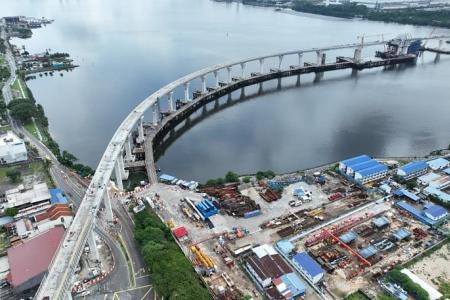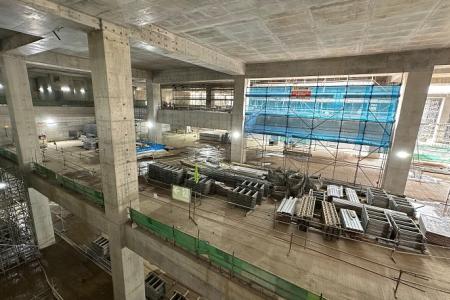JB-SG RTS Link: Installation of rail systems on track to start soon
The installation of rail systems for the Johor Bahru-Singapore Rapid Transit System (RTS) Link is slated to begin from the end of 2024 as scheduled, with good progress being made on both sides of the Johor Strait.
This next phase of work will include laying the tracks, as well as installing the signalling, communications and traction power systems, said Singapore’s Land Transport Authority (LTA), Malaysia’s Mass Rapid Transit Corporation (MRT Corp), and RTS Operations (RTSO).
RTSO is a joint venture formed in 2020 between Singapore rail operator SMRT and Malaysian public transport firm Prasarana to run the 4km cross-border rail shuttle service.
More than 80 per cent of the civil infrastructure works have been completed on the Singapore side of the project, and civil infrastructure works in Malaysia have reached 93 per cent completion, the parties said in a joint statement on Nov 29.
With the marine and land viaducts almost finished, LTA will be ready to progressively grant RTSO access to the civil infrastructures within Singapore from end-2024.
The remaining works in Singapore, such as architectural works, roadworks and the installation of key systems such as immigration gates, will be done in tandem with the rest of the structural works for the rail link.
Additionally, construction work to connect the RTS Link to Woodlands North station on the Thomson-East Coast MRT Line, at Basement 1 of the customs, immigration and quarantine (CIQ) building in Woodlands North, will begin in 2025.
Passenger service on the RTS Link is expected to start by December 2026.
On Malaysia’s end, MRT Corp has already granted RTSO earlier-than-scheduled access to the RTS Link maintenance depot in Wadi Hana, Johor Bahru, since Sept 30, so track installation there can begin.
Access to the remaining railway infrastructure in Malaysia will be handed over to RTSO progressively from end-2024.
The focus at the start of 2025 for the Malaysia side of the project will include fitting out the depot as well as the station and immigration complex in Bukit Chagar, the parties said.
In 2021, nine contracts worth about $320 million were awarded for the RTS Link’s rail systems.
Four of the contracts were for core systems, with Chinese company CRRC Zhuzhou Locomotive taking charge of the rail link’s trains, and the Malaysia and Singapore subsidiaries of Siemens Mobility handling the signalling system.
Sapura Rail Systems, a Malaysian company, was awarded the contract to set up the communications system for the rail link.

Meanwhile, the installation of the traction power system, which supplies electricity to the trains, will be done by Pestech, another Malaysian company.
When ready, the RTS Link will be able to carry up to 10,000 people an hour in each direction between Bukit Chagar and Woodlands North.
This is expected to ease congestion on the Causeway, which handles more than 400,000 crossings daily during peak periods.
For a more seamless travel experience on the RTS Link, the CIQ facilities of both Singapore and Malaysia will be co-located in the same building in Woodlands North and in Bukit Chagar.
This means passengers need to clear immigration only at their point of departure, instead of having to do so a second time when they arrive.
The train journey between the two stations is expected to take about five minutes.
With the RTS Link now connected end to end between Wadi Hana and Woodlands North, LTA and MRT Corp have built a commemorative structure close to where the Singapore and Malaysian sections of the rail viaduct connect.
It depicts the clasping of hands, symbolising the close partnership and ties between the two countries, LTA, MRT Corp and RTSO said.
Get The New Paper on your phone with the free TNP app. Download from the Apple App Store or Google Play Store now


